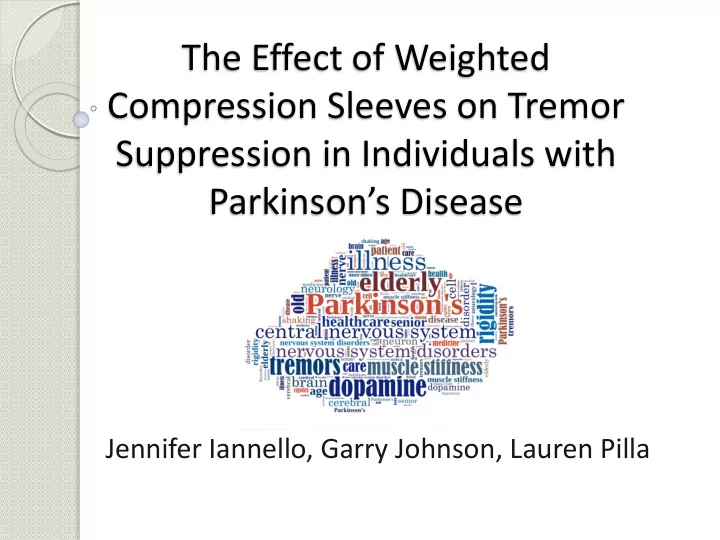

The Effect of Weighted Compression Sleeves on Tremor Suppression in Individuals with Parkinson’s Disease Jennifer Iannello, Garry Johnson, Lauren Pilla
Parkinson’s Disease Second most common chronic, progressive, neurodegenerative disorder 1 Parkinsonian Tremor is one of the most disabling symptoms 2 Dopaminergic medication is current treatment 3
Tremor Impairs Function Involuntary rhythmic and oscillatory movement affecting ~70% of individuals with PD 2 No known cure for tremors 2 Affects activities of daily living (ADLs) 4
Reduced Quality of Life Quality of life affected by functional limitations and low independence in ADLs 5 Fine motor skills affected by tremor contribute to lower levels of independence 5 PD patients experience an overall lower quality of life 6
Basal Ganglia Stimulation Deep brain structure responsible for executing voluntary movement 7 Dopaminergic medication improves intensive, but not coordinative deficits 8 Proprioceptive processing deficits with basal ganglia 9
Promoting Proprioceptive Feedback Proprioception compromised in early PD stages 3 Haptic robotic apparatus promote tremor modulation 4 Proprioceptive feedback from closed-loop system 3
Sensory Integration Through Weighted Apparatus Weighted vest for sensory integration therapy 10 Weighted compression sleeve in patients with PD 11
Weighted Compression Sleeve Allows for proprioceptive feedback Could stimulate basal ganglia outflow New application of compression garments
Hypothesis Men and women with Parkinson’s Disease displaying tremor will have a suppressed tremor amplitude due to proprioceptive feedback when wearing a weighted compression sleeve, compared to those wearing a weighted sleeve, a compression sleeve, and an unweighted sleeve with no compression.
Study Participants Questionnaire for equal functional level Ages 50-70 with tremor for at least 1 year Exclusion criteria 25-30 participants with PD chosen
Conducting the Study Randomly assigned to one of four groups Pegboard set tests fine motor skills ANOVA Weighted compression sleeve most effective
Future Directions Larger scale Used for other tremors Used on other limbs
References 1. Van Den Eeden SK, Tanner CM, Bernstein AL, Fross RD, Leimpeter A, Bloch DA, Nelson LM. Incidence of Parkinson's disease: variation by age, gender, and race/ethnicity. Am J Epidemiol. 2003;157:1015 – 22. 2.. “NINDS Parkinson's Disease Hope Through Research.” U.S National Library of Medicine. U.S. National Library of Medicine, Dec. 2014. 3. J Konczak, DM Corcos, F Horak, H Poizner, M Shapiro, P Tuite, J Volkmann and M Maschke "Proprioception and Motor Control in Parkinson's Disease." Journal of Motor Behavior. Vol. 41, iss. 6, 2009. 4. S. Fahn, R.L. Elton. UPDRS Program Members. Unified Parkinson's disease rating scale. Recent developments in Parkinson's disease, Vol. 2. Florham Park, NJ: Macmillan Healthcare Information; p 153-163, 293-304. 1987. 5. Foster, E. R. Instrumental Activities of Daily Living Performance Among People With Parkinson’s Disease Without Dementia. The American Journal of Occupational Therapy: 68 (3): 353 – 362, 2014. 6. Schrag AA. How does parkinson's disease affect quality of life? A comparison with quality of life in the general population. Movement disorders. 11; 15(6): 1118; 1118. 7. Mannella FF. Selection of cortical dynamics for motor behaviour by the basal ganglia. Biol Cybern. 12; 109(6): 595; 595. 8. Tunik E, Feldman A, Poizner H. Dopamine replacement therapy does not restore the ability of Parkinsonian patients to make rapid adjustments in motor strategies according to changing sensorimotor contexts. Parkinsonism Relat Disord 13: 425 – 433, 2007.
References Continued 9. Boraud T, Bezard E, Bioulac B, Gross C. Ratio of inhibited-to-activated pallidal neurons decreases dramatically during passive limb movement in the MPTP-treated monkey. J Neurophysiol 83: 1760 – 1763, 2000. 10. Densem, J. F., Nuthall, G. A., Bushnell, J., & Horn, J. (1989). effectiveness of a sensory integrative therapy program for children with perceptual-motor deficits. Journal of Learning Disabilities, 22 , 221 – 229. 11. Olson, L. J., & Moulton, H. J. (2004a). Occupational therapists’ reported experiences using weighted vests with children with specific developmental disorders. Occupational Therapy International, 11 , 52 – 66.
Recommend
More recommend